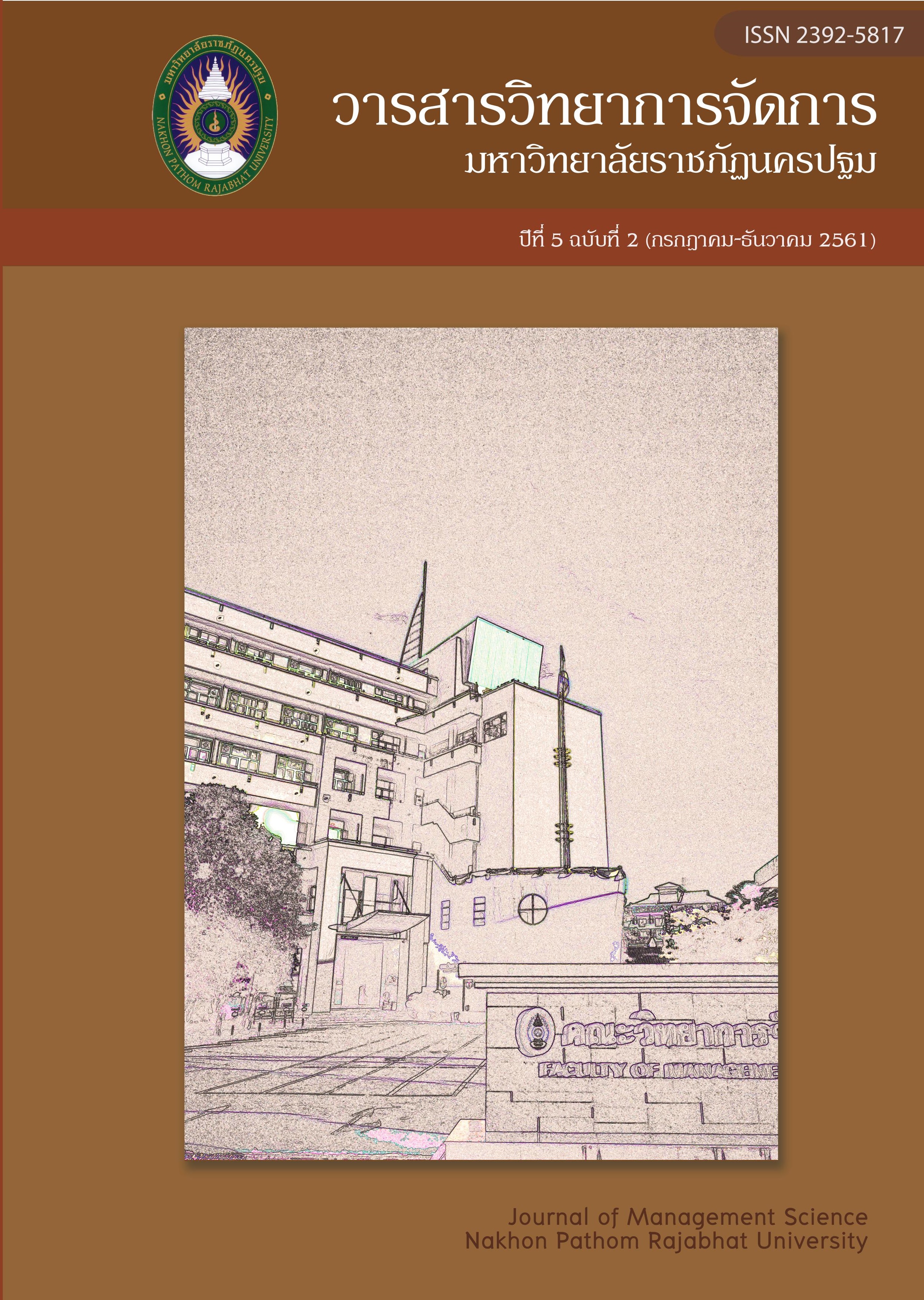Development of integrated marketing communication strategy for building perception of eco-tourism value in Ratchaburi Province
Main Article Content
Abstract
This research aimed to study: 1) the tourists’ eco-tourism behavior; 2) the levels of integrated marketing communication and perception of eco-tourism value; 3) compare the level of perception of eco-tourism value as classified by personal factors; 4) the factors of integrated marketing communication in building perception of eco-tourism value; and 5) guidelines for developing of integrated marketing communication strategy for building perception of eco-tourism value. The research sample was 400 Thai tourists in Ratchaburi Province derived by accidental sampling, and 4 informants derived by purposive sampling. The research instruments were a questionnaire constructed by the researcher, and an in-depth interview guideline. The IOC content validity of the questionnaire was between 0.67-1.00. The internal coefficients of integrated marketing communication were 0.97 for advertisement, 0.91 for selling by sale person, 0.94 for sale promotion, 0.96 for public relations, and 0.94 for direct marketing. The internal coefficients of perception of eco-tourism value were 0.90 for royalty, 0.91 for value recognition, 0.93 for quality perception, and 0.79 for commitment. Data were analyzed with percentage, mean, standard deviation, t-test, one-way analysis of variance, least significance different analysis, correlation coefficient, stepwise multiple regression, and content analysis.
The research results were as follows:
1. Regarding eco-tourism behavior in Ratchaburi Province, most of tourists traveled in Ratchaburi more than 5 times. The purpose of traveling was for recreation. They mostly traveled by personal car. Normally, it was one-day trip. The expense per trip was less than or equal to 1,000 baht.
2. The level of integrated marketing communication was at a high level. The aspects were selling by sale person, advertisement, direct marketing, sale promotion, and public relations. The level of perception of eco-tourism value was at a high level. The aspects were commitment, value recognition, quality perception, and royalty.
3. The eco-tourists as classified by gender, age, education, and occupation had different level of perception of eco-tourism value with statistical significance level of .05. However, there was no difference among those with different monthly income and hometown.
4. The factor of integrated marketing communication in the aspects of direct marketing (X5), selling by sale person (X2), and public relations (X4) together predicted the perception of eco-tourism value at the percentage of 57 with statistical significance at .01. The regression equation was "Y" ̂_"tot" = 1.24 + 0.26 (X5) + 0.24 (X2) + 0.189 (X4).
5. The guidelines for development of integrated marketing communication strategy for building perception of eco-tourism value in Ratchaburi were: 1) producing clear, comprehensive and appropriate advertising media to disseminate tourist attraction information in response to tourists’ needs; 2) organizing sufficient staff to provide tourist information service. The staff should have good knowledge, communication skill, good personality, gentle manners, and dress neatly and appropriately; 3) promoting tourism by organizing special activities etc.; 4) doing public relations about tourist attractions through various media channel, so that tourists could access to sufficient information in accordance with their needs; 5) doing advertisement and public relations of tourism through the Internet regularly, and holding seminar of relevant person in both private and government sectors for giving suggestion and information about eco-tourism attractions in Ratchaburi Province.
Article history : Received 18 July 2017
Revised 10 October 2017
Accepted 16 October 2017
SIMILARITY INDEX = 0.00
Article Details
The views and opinions of the article appearing in this journal are those of the author. It is not considered a view and responsibility of the editorial staff.
References
กมลรัตน์ โถวสกุล. (2550). การรับรู้เครื่องมือการสื่อสารทางการตลาดที่มีผลต่อการท่องเที่ยวในตลาดน้ำอัมพวา จังหวัดสมุทรสงคราม.วิทยานิพนธ์บริหารธุรกิจมหาบัณฑิตสาขาวิชาการตลาด. บัณฑิตวิทยาลัย. มหาวิทยาลัยเทคโนโลยีราชมงคลธัญบุรี.
กรมการท่องเที่ยว. (2558). สถิตินักท่องเที่ยว. [ออนไลน์]. ค้นเมื่อ 25 มกราคม 2559, จาก https://www.newdo2.samartmultimedia.com/ home/listcontent/11/221/276.
ฉัตรฆฤณ พิชัยกมลฉัตร. (2550). การประเมินศักยภาพการวิเคราะห์แหล่งท่องเที่ยวในจังหวัดนนทบุรี.วิทยานิพนธ์อักษรศาสตร์มหาบัณฑิต.สาขาวิชาภูมิศาสตร์.จุฬาลงกรณ์มหาวิทยาลัย.
บุญเลิศ จิตตั้งวัฒนา. (2548).อุตสาหกรรมการท่องเที่ยว.กรุงเทพฯ : เพรส แอนด์ ดีไซท์.
ปราโมชน์ รอดจำรัส. (2553). พฤติกรรมนักท่องเที่ยว.กรุงเทพฯ : สำนักพิมพ์มหาวิทยาลัยรามคำแหง.
พนิดา พนิตธำรง. (2554). ปัจจัยการสื่อสารการตลาดแบบครบวงจรที่มีความสัมพันธ์กับพฤติกรรมการใช้บริการธุรกิจนำเที่ยวต่างประเทศของนักท่องเที่ยวชาวไทยในเขตกรุงเทพมหานคร. วิทยานิพนธ์บริหารธุรกิจมหาบัณฑิต สาขาวิชาการจัดการ บัณฑิตวิทยาลัย สถาบันรัชต์ภาคย์.
พิชัย นิรมานสกุล. (2554). พฤติกรรมการท่องเที่ยว การเปิดรับข่าวสาร การรับรู้ภาพลักษณ์และการยอมรับคุณค่าแบรนด์เมืองไทย.วิทยานิพนธ์นิเทศศาสตรมหาบัณฑิต.สาขาวิชานิเทศศาสตร์.บัณฑิตวิทยาลัย.มหาวิทยาลัยหอการค้าไทย.
พิษณุ วงศ์เกษม. (2548). ความพึงพอใจของนักท่องเที่ยวต่อการท่องเที่ยวเชิงนิเวศในเขตป่าอนุรักษ์ ภูพระบาท อำเภอเมือง จังหวัดอุดรธานี. วิทยานิพนธ์วิทยาศาสตรมหาบัณฑิต .สาขาวิชาส่งเสริมการเกษตร บัณฑิตวิทยาลัย มหาวิทยาลัยขอนแก่น.
เสาวคนธ์ บุญสมธป. (2551). กลยุทธ์การตลาดการท่องเที่ยวเชิงนิเวศ จังหวัดนครปฐม. วิทยานิพนธ์ศิลปศาสตรมหาบัณฑิต สาขาวิชาการจัดการโรงแรมและการท่องเที่ยว บัณฑิตวิทยาลัย มหาวิทยาลัยนเรศวร.
Aaker, D. (1991). Managing brand equity: Capitalizing on the value of brand name. New York : Free Press.
Best, J. W. & Kahn, J. V. (1998). Research in education. (8th ed.). Boston : Allyn & Bacon.
Kotler, P. (2003). Marketing Management. (11th ed.) Upper Saddle River, NJ : Prentice Hall.
Krejcie, R. V. & Morgan, D. W. (1970). Determining sample size for research activities. Educational and psychological measurement, 30 (3), 607-610.
Shimp, T. A. (2000). Advertising, Promotion and Supplemental Aspects of Integrated Marketing Communications. (5th ed.). Orlando, FL : Dryden Press.


